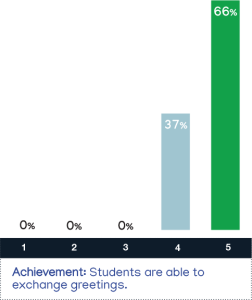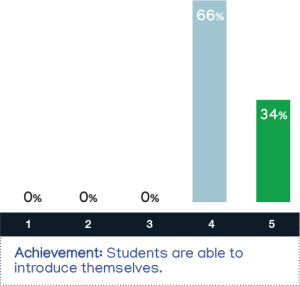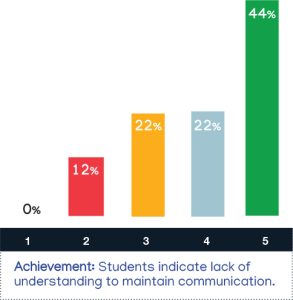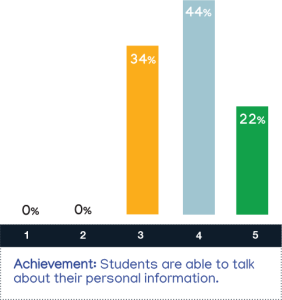Case Study: Student Progress in Meg Spanish Language Program
Monitoring student assessment data helps Meg improve our program. It gives us an indicator of whether students are making adequate improvement each year, allowing us to provide support where it is needed most.
The findings below illustrate the level of achievement for Meg students for an oral communication assessment. For this analysis, we randomly sampled a group of middle school students who participated in the Meg program from 2019-2020, completing up to 3 sessions of Spanish lessons per week.
The analysis reports the student results across 5 domains. This analysis was conducted in order to ascertain general level of achievement for students within their first year of the Spanish program.
Breakdown of all achievements are shown by point and rubric.
Key Findings After 1 Year of Learning
 Domain 1: Sustaining Short Conversations
Domain 1: Sustaining Short Conversations
86% of students could describe and give information about themselves, their preferences, environment, experiences, and interests while 80% of students could effectively translate everyday expressions and use context to assist with interpretation. All students were able to sustain a short conversation while 66% of them could sustain it confidently. Students could understand and respond to questions related to their personal information: name, age, email, phone number and nationality.
5 = Students use greetings and good-byes confidently to start and finish an interaction. Selects between formal and informal with ease.
4 = Students use greetings and good-byes to start and finish an interaction. He/she requires some time to think before selecting a formal or informal greeting.
3 = Students struggle to understand greetings and good-byes, take some time to understand and are not aware of formal/informal forms.
2 = Students are able to either initiate or finish a conversation, but not both of them.
1 = Students do not respond to greetings or good-byes, either formal or informal.

 Domain 2: Introducing Themselves
Domain 2: Introducing Themselves
All students were able to introduce themselves and ask for someone else’s name and surname.
5 = Students are able to introduce him/herself with confidence and ask for someone else’s name and surname.
4 = Students are able to introduce him/herself with ease, but takes some time to formulate the questions to ask for someone else’s name and surname.
3 = Students are able to introduce him/herself with ease, are able to ask for someone else’s name, but struggles to ask for their surname.
2 = Students struggle to introduce him/herself and to ask for someone else’s name and surname.
1 = Students are not able to introduce him/herself.

 Domain 3: Seeking clarification and articulating their lack of understanding in order to maintain communication.
Domain 3: Seeking clarification and articulating their lack of understanding in order to maintain communication.
88% of students could articulate their lack of understanding and ask for repetition when the Spanish teacher talks rapidly in Spanish (No entiendo, ¿puedes repetir, por favor?). Additionally, these students use “¿Cómo se dice/escribe?” when the teacher is either talking about a class object or introducing him/herself.
5 = Student shows a lack of understanding and asks for repetition. He/she is able to answer how to write and how to say a word/objects/names.
4 = Student shows a lack of understanding and asks for repetition. Students take some time to answer “how do you write/say?” questions, but answers appropriately.
3 = Student shows a lack of understanding and asks for repetition. Students struggle to answer “how do you write/say?” questions, and might answer incorrectly.
2 = Students are either able to show a lack of understanding and ask for repetition or answers to “how do you write/say?” questions, but not both.
1 = Students do not express lack of understanding nor ask for repetition. Students are unable to answer “how do you write/say?” questions.

 Domain 4: Giving personal information and sustaining conversation.
Domain 4: Giving personal information and sustaining conversation.
All students were able to understand questions related to their name, age, email, phone number, and nationality while 66% of them were able to effectively respond to these questions.
5 = Students are able to understand and respond confidently to questions related to their personal information.
4 = Students demonstrate understanding of the questions, but takes some time to answer appropriately.
3 = Students demonstrate understanding of the questions, but struggles to respond to them.
2 = Students understand the questions with difficulty and answers to them in English.
1 = Students do not show understanding of the questions and are unable to respond to them.
Share this post

